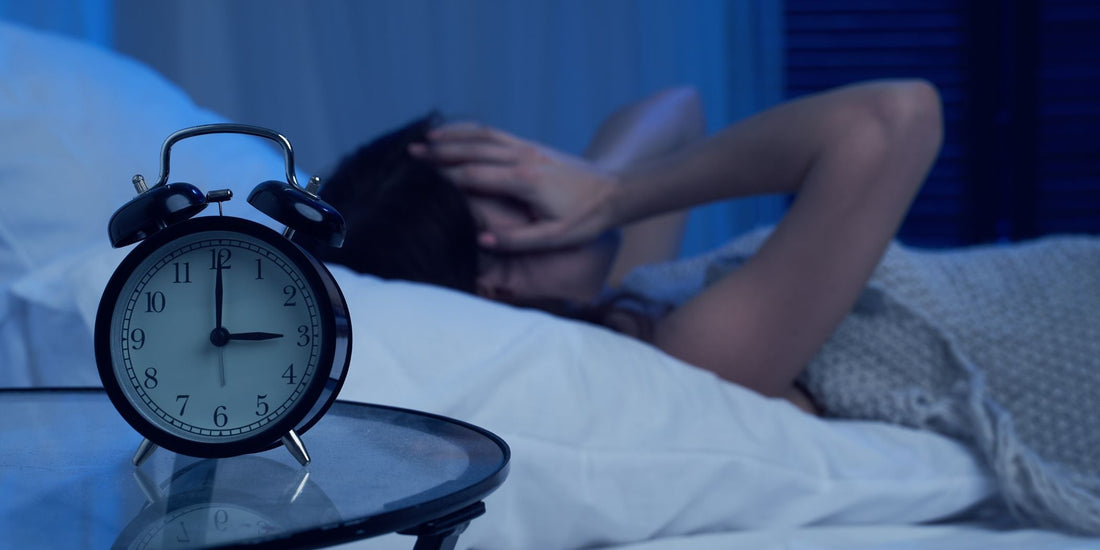
Perimenopause & Sleep
For many women, the first signs of perimenopause aren’t hot flashes or missed periods; it's sleep disruption. Waking at 3 am with your mind racing, sleep cycles are lighter, more fragmented and never quite refreshing. These changes aren’t in your head. They’re the direct result of the complex hormonal fluctuations that reshape your body and brain during midlife.
Across studies, as many as 60% of women in perimenopause report sleep disruption, making it one of the most common and least discussed symptoms of this life stage. Yet, research also shows that with the right knowledge and targeted strategies, restful, restorative sleep is possible again.
This guide to perimenopause and sleep brings together the most trusted, evidence-based research on perimenopause and sleep, blending medical insights from the North American Menopause Society (NAMS), International Menopause Society (IMS), Study of Women’s Health Across the Nation (SWAN), and other leading authorities.
We’ll explore how hormonal shifts affect your circadian rhythm, the difference between insomnia and sleep fragmentation, when to seek clinical support, and how both medical and natural approaches can work together.
By the end, you’ll have a clear understanding of why sleep changes during perimenopause and what you can do about it, with insights from experts like Dr. Mary Claire Haver, Dr. Pauline Maki, and other leaders in women’s health.
Whether you’re seeking science-backed solutions, lifestyle tools, or gentle, natural support, this page is your complete resource for better nights — and brighter days.
What happens to sleep during perimenopause?
Sleep usually becomes lighter and more fragmented during perimenopause, with more awakenings after sleep onset and greater night-to-night variability.
Large longitudinal data show that as women enter the menopausal transition, sleep duration and satisfaction decline while nocturnal awakenings increase, especially when night sweats and mood changes are active.
Beyond vasomotor symptoms, circadian timing can shift (earlier wake times), and many women describe “2–3 a.m. wake-ups.” This pattern of WASO (wake after sleep onset) is a hallmark of the transition.
In her research "Sleep disturbance associated with the menopause,"
Prof. Pauline Maki, PhD, says "sleep disturbances in menopause stem from hormonal changes plus vasomotor and mood symptoms."
Why do hormone fluctuations cause poor sleep?
Because fluctuating estrogen and progesterone alter thermoregulation, neurotransmission (e.g., serotonin, GABA), and circadian signals, which together raise the odds of hot-flash awakenings and “tired-but-wired” nights.
Estrogen supports serotonin/melatonin pathways and temperature stability; progesterone has GABA-ergic calming effects. When these hormones swing or decline, the hypothalamic “thermostat” becomes over-responsive, producing hot flashes/night sweats that wake you. At the same time, cortisol can spike at night, causing early-morning awakenings.
How common are sleep problems in perimenopause?
Between roughly 40% and 60% of women report significant sleep disturbance during the transition, making it one of the most common symptoms of midlife.
Prevalence varies by stage and by the presence of hot flashes and mood symptoms, but across cohorts like SWAN and patient guidance from the NIA, sleep complaints peak in late perimenopause and can continue into early postmenopause.
What are the health impacts of poor sleep during perimenopause?
Chronic midlife sleep loss is linked to higher risk of hypertension, insulin resistance/diabetes, depression/anxiety, cognitive decline, and accelerated biological aging — and improving sleep reverses part of this burden.
Research from the International Menopause Society's (IMS) 2025 Restorative Sleep white paper emphasizes that non-restorative sleep in menopause correlates with cardiometabolic and mental-health risks and that addressing sleep is central to women’s midlife health.
Better sleep can also dampen vasomotor frequency/severity, break pain-sleep cycles, and improve daytime function and work productivity.
When should you talk to a doctor about sleep issues?
See a clinician if sleep problems last longer than 3 months, or if you have snoring, choking/gasping, severe daytime sleepiness, mood changes, or unrefreshing sleep despite adequate time in bed.
These are red flags for conditions like obstructive sleep apnea (OSA), restless legs, depression, thyroid dysfunction, or other medical contributors. The USPSTF advises symptom-based evaluation (not blanket screening).
Also speak to your clinician if night sweats remain intense despite lifestyle changes — you may benefit from VMS-targeted therapy (hormonal or nonhormonal) that can indirectly improve sleep.
What treatments actually help women sleep better during perimenopause?
The best results come from combining CBT-I (first-line for chronic insomnia) with appropriate treatment of vasomotor symptoms (e.g., MHT when suitable), plus targeted nonhormonal options and sleep-disorder evaluation when indicated.
A JAMA Internal Medicine randomized trial of telephone CBT-I in peri/postmenopausal women showed clinically significant and durable improvements.
The NAMS 2022 Position Statement confirms MHT is the most effective treatment for hot flashes/night sweats and sleep improves when VMS are the driver.
Certain SSRIs/SNRIs, gabapentin, and clonidine reduce VMS and secondarily improve sleep; discuss risks/benefits with your clinician.
Can lifestyle changes really improve perimenopausal sleep?
Yes. Consistent circadian habits and a cooling, low-stimulus sleep environment measurably reduce sleep latency and nighttime awakenings in midlife women.
Try these evidence-aligned steps to improve sleep during perimenopause:
• Timing: Fixed bed/wake times (even weekends) re-entrain circadian rhythms.
• Light: 10–15 minutes of morning daylight anchors melatonin timing.
• Environment: 17–19 °C room, dark/quiet; cooling fabrics for night sweats.
• Stimulants: Limit caffeine after noon; keep alcohol moderate/avoid near bedtime (both fragment sleep).
• Wind-down: Breathing, yoga, journaling aim to lower cortisol.
• Movement: Daytime aerobic activity improves slow-wave sleep.
Read our article for more information about The Importance of Bedtime Routines for Restful Sleep During Perimenopause.
What is CBT-I and does it work for perimenopause?
CBT-I (Cognitive Behavioral Therapy for Insomnia) is the first-line, medication-free treatment for chronic insomnia, and multiple trials show it significantly improves sleep in peri/postmenopausal women.
CBT-I blends stimulus control (bed = sleep only), sleep restriction (consolidates sleep), cognitive re-framing (reduces sleep worry), and relapse prevention. A 2024 meta-analysis confirmed better sleep efficiency, longer total sleep time, and lower insomnia severity in menopausal cohorts receiving CBT-I.
What role does hormone therapy play in sleep improvement?
Hormone therapy can meaningfully improve sleep when hot flashes/night sweats are the main disruptors, but it’s not prescribed solely as a sleep aid and must be individualized.
By treating vasomotor symptoms, MHT reduces nocturnal awakenings and improves sleep continuity; progesterone can add GABA-like calming. Appropriateness depends on personal risk–benefit profile (age, time since last period, CVD/breast history. For women who cannot or prefer not to use MHT, nonhormonal VMS therapies and CBT-I remain effective strategies.
